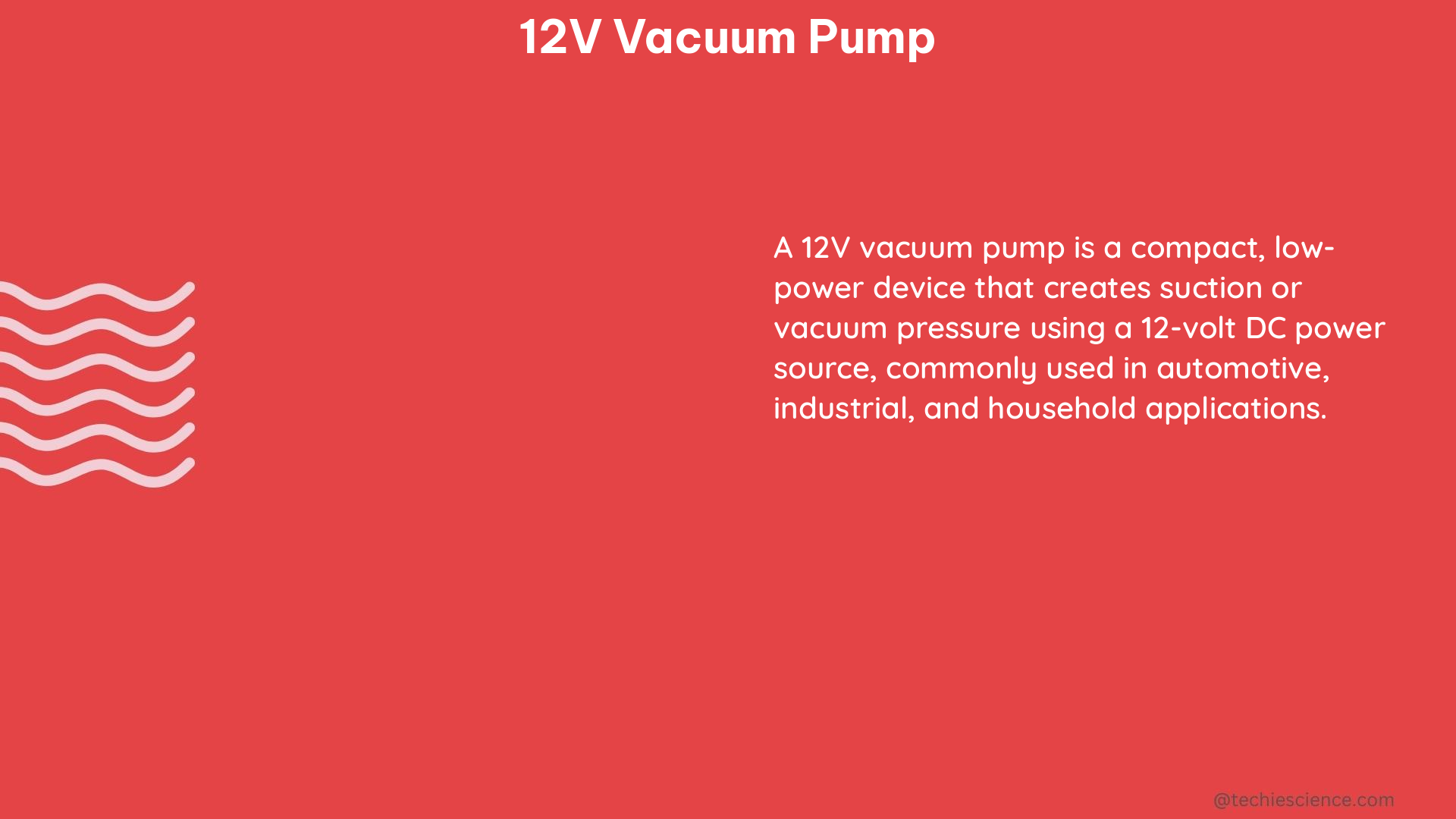A 12V vacuum pump is a versatile and essential tool used in various applications, including automotive systems, industrial processes, and DIY projects. This comprehensive guide will delve into the technical specifications, unique perspectives, and a DIY approach to working with a 12V vacuum pump.
Technical Specifications of a 12V Vacuum Pump
-
Voltage: A 12V vacuum pump operates at a nominal voltage of 12 volts, which can be supplied by a battery or a power adapter. The voltage range for these pumps typically falls between 11.5V to 13.8V, ensuring optimal performance.
-
Current Draw: The current draw of a 12V vacuum pump can vary depending on the model and the load. For instance, the pump from SparkFun Electronics has a minimum current draw of 0.40A and a maximum current draw of 0.54A when connected to a 12V variable power supply. It’s essential to consider the pump’s current requirements when selecting a power source to avoid overloading the circuit.
-
Suction Power: A 12V vacuum pump can generate a suction force sufficient for most small projects. The SparkFun vacuum pump, for example, can produce a vacuum of up to 16″ Hg (inches of mercury), which is equivalent to approximately 6.67 kPa (kilopascals). This suction power is suitable for tasks such as holding workpieces, lifting objects, or operating pneumatic tools.
-
Noise Level: The noise level of a 12V vacuum pump can range from 50 to 70 dB, depending on the model and the operating conditions. Quieter models are available for use in residential or noise-sensitive environments, while louder pumps may be more suitable for industrial applications.
-
Speed Control: Some 12V vacuum pumps come with speed control features, allowing users to adjust the pump’s performance according to their needs. This can be achieved through pulse-width modulation (PWM) or other control methods, providing greater flexibility and efficiency.
-
Dimensions and Weight: The size and weight of a 12V vacuum pump can vary significantly, ranging from compact models suitable for portable applications to larger pumps designed for industrial use. Carefully consider the physical dimensions and weight of the pump to ensure it fits your specific requirements.
Unique Perspective

When working with a 12V vacuum pump, it’s crucial to consider the quality and stability of the power supply. A fluctuating or unstable power supply can negatively impact the pump’s performance and lifespan. Using a power supply with a constant current mode, as suggested in the Reddit thread Best way to power this 12VDC mini vacuum pump?, can help maintain the pump’s optimal operating conditions.
Additionally, understanding the pump’s amp draw under load is essential, especially when connecting it to other components, such as a brake booster. If the pump draws more current than the fuse can handle, it may blow the fuse, necessitating a higher amp fuse or a different power supply. The Reddit thread Newbie questions about 12v vacuum pumps provides valuable insights on this topic.
DIY Approach
For those interested in a DIY approach, it is possible to build a speed control circuit for a 12V vacuum pump. This can be achieved using an Arduino, a diode, and a transistor, as discussed in the Arduino forum thread Vacuum Pump. By following the steps and wiring diagrams provided, users can create a custom speed control solution tailored to their specific needs.
The key components for a DIY 12V vacuum pump speed control circuit include:
- Arduino board (e.g., Arduino Uno, Arduino Nano)
- Diode (e.g., 1N4001)
- Transistor (e.g., 2N2222)
- Potentiometer (for manual speed control)
- Wiring and breadboard (for prototyping)
By implementing this DIY approach, users can fine-tune the pump’s performance, adjust the speed, and potentially extend the pump’s lifespan by avoiding unnecessary high-speed operation.
Conclusion
A 12V vacuum pump is a versatile and essential tool with a wide range of applications. Understanding its technical specifications, such as voltage, current draw, suction power, noise level, speed control, and physical dimensions, is crucial for successful implementation. Additionally, considering factors like power supply quality and amp draw under load can enhance the pump’s performance and longevity.
For those interested in a DIY approach, building a custom speed control circuit using an Arduino, diode, and transistor can provide greater flexibility and control over the pump’s operation. By following the guidance and resources provided in this comprehensive guide, users can confidently work with 12V vacuum pumps and tackle a variety of projects.
References
- Best way to power this 12VDC mini vacuum pump?
- Newbie questions about 12v vacuum pumps
- Vacuum Pump
- 12 Volt Vacuum Pump Amp Draw Question
- SparkFun Vacuum Pump

The lambdageeks.com Core SME Team is a group of experienced subject matter experts from diverse scientific and technical fields including Physics, Chemistry, Technology,Electronics & Electrical Engineering, Automotive, Mechanical Engineering. Our team collaborates to create high-quality, well-researched articles on a wide range of science and technology topics for the lambdageeks.com website.
All Our Senior SME are having more than 7 Years of experience in the respective fields . They are either Working Industry Professionals or assocaited With different Universities. Refer Our Authors Page to get to know About our Core SMEs.